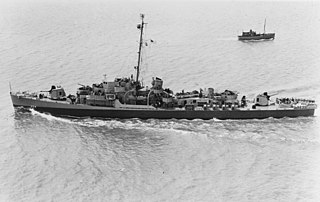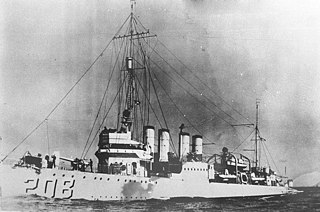
USS Dickerson (DD-157) was a Wickes-class destroyer in the United States Navy, and was converted to a high-speed transport at Charleston, South Carolina and designated APD-21 in 1943. She was named for Mahlon Dickerson (1770–1853), Secretary of the Navy from 1834 to 1838.

USS Palmer (DD-161) was a Wickes-class destroyer of the United States Navy, later converted to a minesweeper and reclassified as DMS-5. She was named for Rear Admiral James Shedden Palmer USN (1810–1867).

USS Long (DD-209/DMS-12), named for John Davis Long (1838–1915), Secretary of the Navy from 1897 to 1902, was a Clemson-class destroyer of the United States Navy.

USS Herbert (DD-160) was a Wickes-class destroyer. She was named for Hilary A. Herbert (1834–1919), Secretary of the Navy from 1893 to 1897.

USS Chandler (DD-206/DMS-9/AG-108) was a Clemson-class destroyer in the United States Navy. She was the only ship named for William Eaton Chandler, who served as Secretary of the Navy from 1882 to 1886.

USS Schley (DD-103) was a Wickes-class destroyer in the United States Navy during World War I and later designated, APD-14 in World War II. She was the first ship named in honor of Winfield Scott Schley.

USS Rathburne (DD–113) was a Wickes-class destroyer in the United States Navy during both World Wars. She was the first ship named for John Peck Rathbun.

USS Crosby (DD–164) was a Wickes-class destroyer in the United States Navy during World War II, later reclassified as APD-17. She was named for Admiral Peirce Crosby.

USS Rudderow (DE-224) was the lead ship of her class of destroyer escorts, in service with the United States Navy from 1944 to 1947. After spending decades in reserve, she was sold for scrap in 1970.

USS Manley (DD-74/AG-28/APD-1), a Caldwell-class destroyer, served in the United States Navy. She was the second Navy ship named for Captain John Manley (c.1733–1793).

USS Hovey (DD-208/DMS-11) was a Clemson-class destroyer in the United States Navy during World War II. She was the only ship named for Ensign Charles Hovey (1885–1911).

USS Gilmer (DD-233/APD-11) was a Clemson-class destroyer in the United States Navy during World War II. She was the first ship named for Secretary of the Navy Thomas Walker Gilmer.

USS Humphreys (DD-236/APD-12) was a Clemson-class destroyer in the United States Navy during World War II. She was named for Joshua Humphreys, a pioneer US shipbuilder.

USS Overton (DD-239/APD–23) was a United States Navy Clemson-class destroyer and high-speed transport that saw service during World War II.

USS Hopkins (DD-249/DMS-13) was a Clemson-class destroyer built in 1920 and in United States Navy service between 1921 and 1946. The third Navy ship named in honor of Commodore of the Continental Navy Esek Hopkins, she saw extensive action in the Pacific Theatre during World War II, emerging the most decorated Clemson-class warship of that conflict.

USS Belknap (DD-251/AVD-8/DD-251/APD-34) was a Clemson-class destroyer in the United States Navy during World War II. She was named for Rear Admiral George Belknap.

The third USS Merrimack (AO-37) (ex-Caddo) was one of five Kennebec-class fleet oilers built during World War II for service in the United States Navy. She also service in the Cold War. She was named after the Merrimack River in Massachusetts and New Hampshire.

USS Lloyd (DE-209/APD-63), a Buckley-class destroyer escort of the United States Navy, was named in honor of Ensign William R. Lloyd (1916–1942).

The Invasion of Lingayen Gulf, 6–9 January 1945, was an Allied amphibious operation in the Philippines during World War II. In the early morning of 6 January 1945, a large Allied force commanded by Admiral Jesse B. Oldendorf began approaching the shores of Lingayen from Lingayen Gulf, on the island of Luzon. U.S. Navy and Royal Australian Navy warships began bombarding suspected Japanese positions along the coast of Lingayen from their position in Lingayen Gulf for three days. On "S-Day", 9 January, the U.S. 6th Army landed on a roughly 25 mi (40 km) beachhead at the base of the Gulf between the towns of Lingayen and San Fabian.
Destroyer minesweeper was a designation given by the United States Navy to a series of destroyers that were converted into high-speed ocean-going minesweepers for service during World War II. The hull classification symbol for this type of ship was "DMS." Forty-two ships were so converted, beginning with USS Dorsey (DD-117), converted to DMS-1 in late 1940, and ending with USS Earle (DD-635), converted to DMS-42 in mid-1945. The type is now obsolete, its function having been taken over by purpose-built ships, designated as "minesweeper (high-speed)" with the hull classification symbol MMD.



















